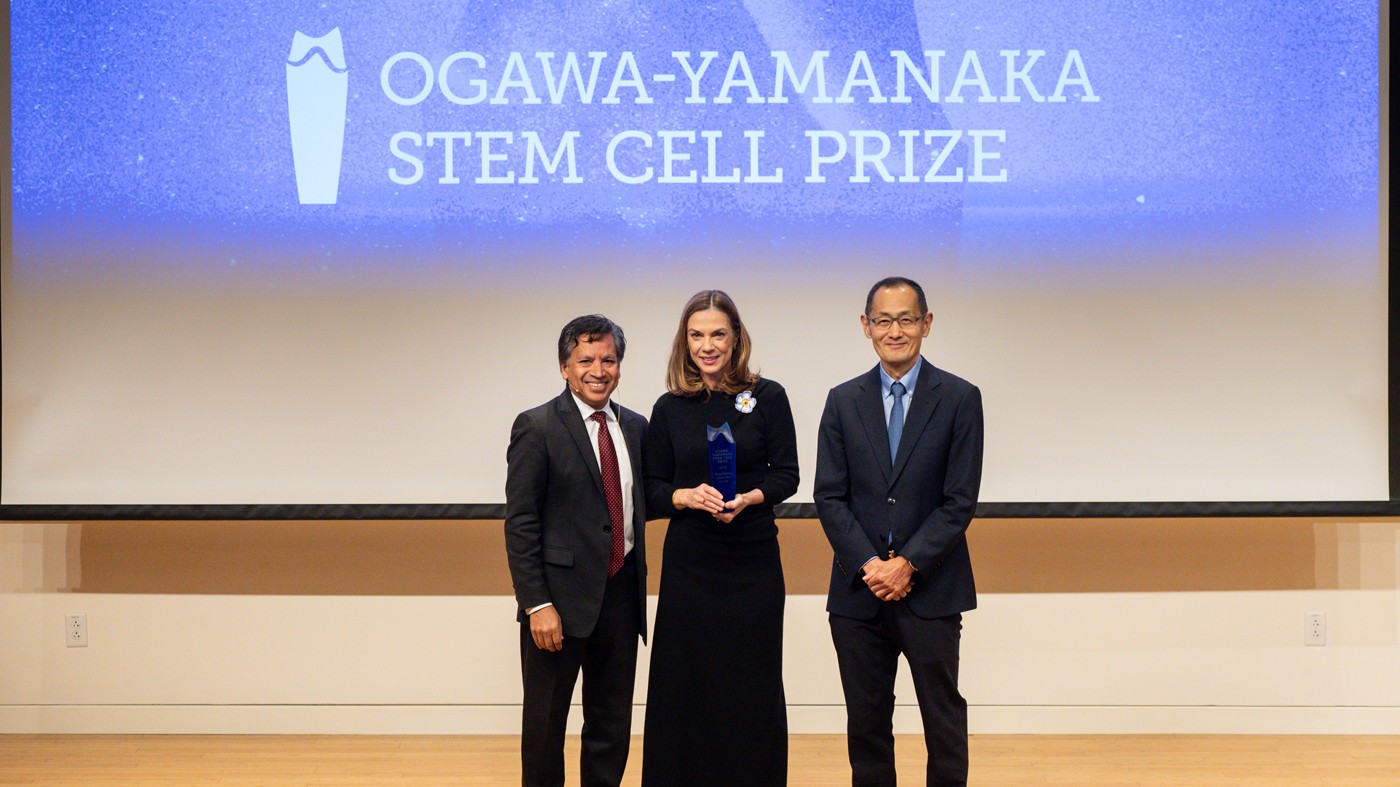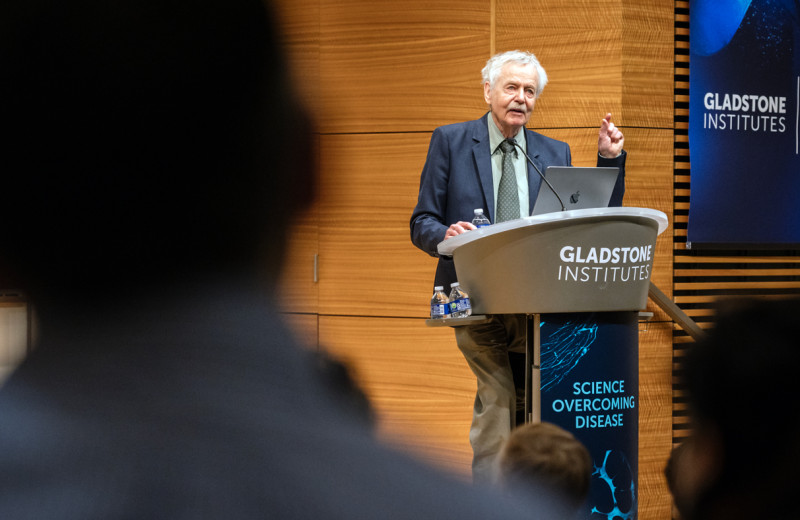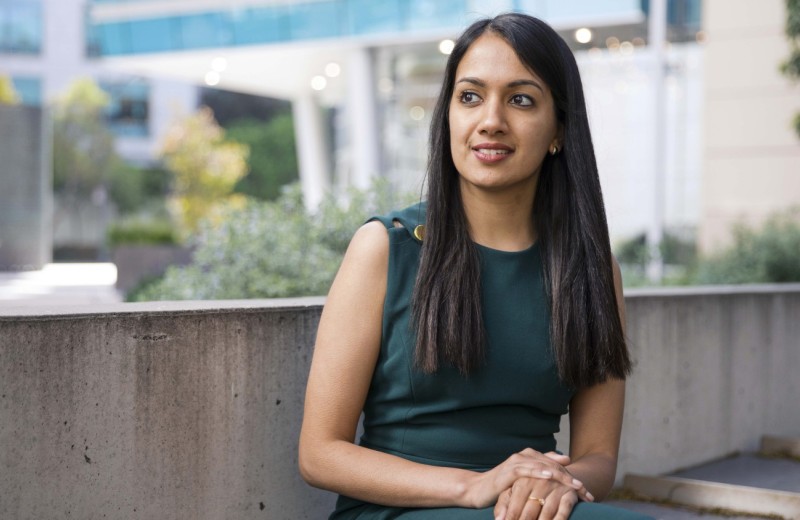Gladstone NOW: The Campaign Join Us on the Journey✕

The Ogawa-Yamanaka Stem Cell Prize recognizes groundbreaking work in translational regenerative medicine using reprogrammed cells. Magdalena Zernicka-Goetz provided highlights of her recent discoveries with a full audience in Gladstone’s Mahley Auditorium after accepting the 2023 Ogawa-Yamanaka Stem Cell Prize.
The human embryo is ripe with possibility: from just a few cells, a unique person arises with their own individual and distinct traits.
Beginning early in an embryo’s development, cells have the potential to divide and grow into any of myriad tissue types in the body. The plasticity of these young embryonic cells—meaning their ability to become any cell in the body—makes the human embryo fertile ground for understanding the earliest stages of life, and how these stages can falter or be repaired.
For the past 25 years, Magdalena Zernicka-Goetz, PhD, has studied and harnessed the plasticity of mammalian embryos.
“I’m captivated by the concept of embryonic plasticity,” Zernicka-Goetz says. “It’s amazing to consider how cells that are not yet programmed to do one thing versus another can be nudged to follow different fates.”
Fueled by that fascination, she has uncovered previously unknown fundamental mechanisms of mammalian embryonic development, and created models that closely mimic early mouse and human embryos and self-assemble from stem cells in a dish.
These field-shaping accomplishments have earned Zernicka-Goetz the 2023 Ogawa-Yamanaka Stem Cell Prize, which is supported by Gladstone Institutes and Cell Press.
“It’s difficult to overstate the importance of Magdalena’s work,” says Deepak Srivastava, MD, president of Gladstone and chair of the prize’s selection committee. “We are proud to recognize her contributions to our understanding of human development, the tools available to study it, and the future of regenerative medicine.”
Since 2015, the Ogawa-Yamanaka Stem Cell Prize has celebrated scientists who advance the field of regenerative medicine through their use of cellular reprogramming. Betty and Hiro Ogawa also established the prize to honor Gladstone Investigator Shinya Yamanaka, MD, PhD, who developed a Nobel prize-winning strategy for reprogramming adult human skin cells into induced pluripotent stem cells, which are cells that can be coaxed into becoming nearly any cell type in the body. Support of this prize is continued by their sons, Marcus and Andrew Ogawa.
On Thursday, November 16, Zernicka-Goetz received the award and an unrestricted prize of $150,000 during a ceremony held at Gladstone in San Francisco.
“Receiving this prize means everything to me,” says Zernicka-Goetz. “Shinya is one of my personal heroes, and it’s incredible to be appreciated by my colleagues in his honor, for the research to which I have devoted so much of my life.”
Early Life in the Lab
In a sense, the earliest stages of Zernicka-Goetz’s own life began in the lab. Her mother and her father, a neurobiologist conducting research in Warsaw during Poland’s communist period, could not afford an apartment for the first 5 years of her life. Instead, they lived at the research institute where her father worked.
“I remember playing in the corridors while being surrounded by white lab coats and thinking that everybody in the world must be obsessed with some kind of scientific mechanism,” she recalls. “But I never thought I would be a scientist like my father; I was more interested in rescuing cats from his laboratory. But my childhood friend reminds me that I loved to do experiments, for example, mixing my mother’s and her mother’s face creams when they were at work.”

Gladstone President Deepak Srivastava (left), prize winner Magdalena Zernicka-Goetz (center), and Gladstone Senior Investigator and Nobel Laureate Shinya Yamanaka (right) share a moment on stage after Zernicka-Goetz received the award on November 16, 2023.
Zernicka-Goetz also regularly participated in “happenings,” secret gatherings usually held in people’s apartments where she and other artists freely expressed their creativity and their opposition to the communist regime through art installations and theatrical performances.
“There was a certain electricity in the air to go against the current of the communist status quo and to counter the restrictions of freedom perpetrated by the regime,” she says.
In high school, against her expectations, she found herself drawn to life sciences.
“Biology seemed fascinating and complex, and it required creativity, an abstract way of thinking,” she says.
By 1989, when communist rule of Poland came to an end, she was working on her PhD at the University of Warsaw, studying the embryos of mice, bank voles, and rats under the guidance of Andrzej Tarkowski, PhD, a pioneer of experimental embryology.
“I had to be particularly resourceful with bank voles as they were brought to me every second week from the wild, from a village called Bialowieza in the last remaining parts of the primeval forest at the Polish-Russian border, and they were biting my fingers,” says Zernicka-Goetz.
“We barely had any funding for research, so we could only do very simple experiments, but I learned so much about how to manipulate embryos and how to think about development,” she adds. “That was where my fascination with embryonic plasticity began.”
With the fall of communism came a life-changing opportunity: a fellowship for Zernicka-Goetz to spend 1 year of her doctorate conducting research at the University of Oxford.
“This was so unexpected as during the communist regime, travelling to the West was practically impossible and getting a fellowship to carry out your PhD work in Oxford was not something anyone could even dream about,” Zernicka-Goetz recalls. This was the first time in history that a small group of PhD students from Poland were given this opportunity. I was the sole scientist in this group.”
“I didn’t think I had a chance, as a foreigner and a woman, so I was sure it was a kind of miracle when I received all three fellowships."
A second career-shaping moment came toward the end of her time as a postdoctoral scholar with renowned biologist Martin Evans, FRS, FMedSci, at the University of Cambridge, where she had devoted nearly every waking hour to creating novel tools so she could follow the fate of cells in a living embryo. She was slated to return to Poland to re-join Tarkowski’s lab, but was encouraged by another trailblazing biologist, John Gurdon, DPhil, DSc, FRS, to apply for fellowships to remain in Cambridge and set up her lab there. Both Evans and Gurdon ultimately received Nobel Prizes for their work, with Gurdon sharing the prize with Yamanaka in 2012.
“I didn’t think I had a chance, as a foreigner and a woman, so I was sure it was a kind of miracle when I received all three fellowships,” Zernicka-Goetz said. “Instead of packing my suitcase, I was able to establish my lab at Cambridge. Martin Evans and John Gurdon were my greatest mentors. They fostered my interest in stem cell biology and the question of pluripotency in development, and they pushed me forward at times when I hesitated.”
At the University of Cambridge—and later with her joint appointment at the California Institute of Technology—she would lead her team in a series of milestone advancements to better understand the beginnings of a human life.
Mimicking the Mammalian Embryo
Zernicka-Goetz loves teamwork.
“I like for people in my lab to keep an open dialogue with each other and with other labs,” she says. “In a way, cells can also be social, and I’m interested in their communication, too.”
Indeed, when it comes to the fate of embryonic cells, communication is key. Cells in a mammalian embryo “talk” by releasing and sensing each other’s signaling molecules, prompting each other to gradually shed their initial flexibility and settle into more distinct cellular identities with specific roles.
Zernicka-Goetz was eager to better understand this process. But first, she needed new tools.
So, in one of her lab’s earliest milestones, she adapted a protocol developed in roundworms so that it could be used for mouse embryos. Harnessing a biological process known as RNA interference, this protocol enabled her to switch off a gene in a single cell of a mouse embryo, while leaving it active in the other cells.
“Being able to perturb cellular communication by targeting one gene in one cell at a time enabled us to show that the fate of the cells in a mammalian embryo becomes nudged in a particular direction at an earlier stage than everyone thought,” she says. “It took some time to uncover the mechanism behind this aspect of cell fate specification, and it was a journey against the current.”
After that landmark discovery, she set her sights on a slightly later and notoriously mysterious phase of mammalian development: when the embryo implants into the mother’s womb. This crucial step could not easily be studied because the embryo is literally hidden in the mother’s tissues.
So, Zernicka-Goetz and her team carefully worked out how to grow and capture images of mouse and human embryos during the implantation stage outside the womb, in a dish in the lab—an achievement that earned her the People’s Choice for Science magazine’s Breakthrough of the Year 2016.
“It was a turning point for us and for other labs, because it opened the door for us to address the question of how cells talk to each other during implantation, when mammalian embryos become much more complex,” she says.
Self-Assembling Embryos
This turning point also sparked a new goal for Zernicka-Goetz. By the implantation stage, embryonic cells have differentiated into three distinct types of stem cells that eventually give rise to different parts of the embryo: these three stem cell populations go on to form the body, the placenta, and the embryo’s nourishing yolk sac.
“I thought that, if we could work out which interactions between embryonic cells were critical during implantation, then we could combine the three types of stem cells involved at this stage. That could allow them to interact to build an embryo-like structure in the lab on their own, without us needing to supply chemical signals to coax them along.”
She and her team embarked on a journey to do exactly that. Over the next several years, they deciphered more and more of the dialogue between the three cell types. They applied this knowledge to develop novel methods for creating self-assembling structures that became increasingly like embryos, as each new method introduced another of the three cell types.
“When we finally combined all three cell types using three different types of mouse stem cells, the result was absolutely mind blowing,” Zernicka-Goetz says. “I knew we would be able to mimic certain stages of embryonic development, but even with all of my embryology knowledge, I couldn’t believe how well these cells self-assembled into structures that looked so much like real, post-implantation mouse embryos.”
By 2022, her team was able to grow their self-assembling mouse embryo-like model in a dish to the point that it developed a beating heart, as well as precursors for all parts of the complete mouse brain. This feat prompted Nature to include the team’s work in its list of “Seven technologies to watch in 2023.”
“I knew we would be able to mimic certain stages of embryonic development, but...I couldn’t believe how well these cells self-assembled into structures that looked so much like real, post-implantation mouse embryos.”
In July 2022, at the annual American Society of Developmental Biology meeting, Zernicka-Goetz announced in her Conklin Medal lecture that her team had used a similar approach to combine the three different types of human stem cells to create a self-assembling structure that closely mimics key features of the human embryo after it implants in the mother’s womb.
This human model lacks brain and heart structures as it develops to an earlier developmental stage, but it contains all of the tissue types that would normally develop into the placenta, the yolk sac, and the embryo itself. The model also contains primordial germ cells, which are the cells that would later become sperm and eggs in a real person. Zernicka-Goetz was able to use the model to dissect the signaling pathway responsible for triggering the formation of these cells.
None of these mouse or human embryo models are capable of becoming actual embryos. However, Zernicka-Goetz says, “Our newest models are more complete than any previously created embryo-like models, and they extend our ability to study the human embryo in the lab and to deepen our understanding of human development and disease.”
Answering Longstanding Questions
Zernicka-Goetz and her team are already using their human embryo-like model to study all the steps that must be fulfilled for an embryo to survive through the implantation phase.
“It’s shocking that about 60 percent of pregnancies are believed to fail at this early stage of our life,” she says. “We want to use our model to determine what cellular dialogue is needed at this time to ensure a successful pregnancy, and how that might be translated into treatments to improve the chances of a healthy pregnancy.”
In the future, they and other researchers may also be able to apply the model to better understand diseases that are triggered when things go wrong during the earliest stages of human development. The model could even help pave the way to methods for growing synthetic organs for transplant.

Gladstone Senior Investigator and Nobel Laureate Shinya Yamanaka discusses the legacy of the Betty and Hiro Ogawa Family, which established the Ogawa-Yamanaka Stem Cell Prize through a generous gift in 2015.
More broadly, Zernicka-Goetz envisions her pioneering achievements being applied in labs around the world to advance human knowledge and health.
“I hope that my contributions will enable researchers to answer the longstanding questions about our own development that were previously impossible to address,” she says. “I hope they will provide insights into how complex tissues and organs form in a coordinated manner to function, and how we can repair them when they are failing.”
And as the newest recipient of the Ogawa-Yamanaka Stem Cell Prize, she sees meaningful parallels between her and Yamanaka’s work.
“We’re looking at two sides of the same coin,” she says. “Shinya changed our way of thinking about stem cells and showed us it was possible to take mature cells and reverse them to a state where they act like stem cells. And I’m trying to understand the same kind of process, but from the opposite end: how can we influence stem cells so they can develop different fates.”
“Because of that, I not only admire Shinya’s work, but it guides me,” adds Zernicka-Goetz. “So, to receive the Ogawa-Yamanaka Stem Cell Prize? There is no bigger honor.”
Support Discovery Science
Your gift to Gladstone will allow our researchers to pursue high-quality science, focus on disease, and train the next generation of scientific thought leaders.
A Sculptor of Modern Regenerative Medicine
A Sculptor of Modern Regenerative Medicine
Among his myriad accomplishments, Rudolf Jaenisch—winner of the 2025 Ogawa-Yamanaka Stem Cell Prize—was the first to demonstrate the potential of induced pluripotent stem cells to treat disease.
Awards Ogawa Stem Cell Prize Profile Regenerative Medicine Stem Cells/iPSCsSix Gladstone Scientists Named Among World’s Most Highly Cited Researchers
Six Gladstone Scientists Named Among World’s Most Highly Cited Researchers
The featured scientists include global leaders in gene editing, data science, and immunology.
Awards News Release Corces Lab Doudna Lab Marson Lab Pollard Lab Ye LabBringing Modern Science to Vitamin Biology: Isha Jain Wins NIH Transformative Research Award
Bringing Modern Science to Vitamin Biology: Isha Jain Wins NIH Transformative Research Award
Leveraging modern scientific tools and techniques, Jain intends to transform our understanding of the critical roles that vitamins play in health and disease.
Awards News Release Cardiovascular Disease Jain Lab Metabolism



